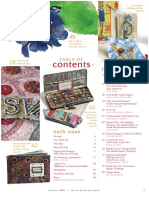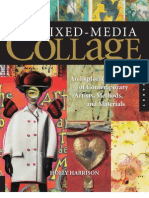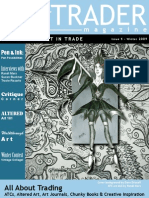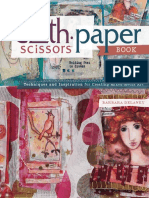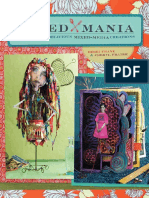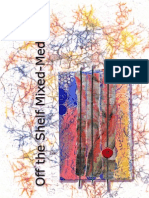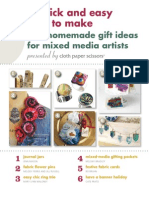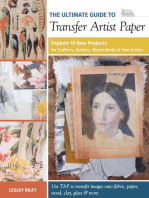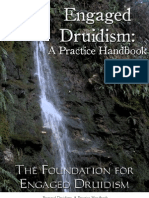Interviews With: All About Trading
Interviews With: All About Trading
Uploaded by
sumendersinghCopyright:
Available Formats
Interviews With: All About Trading
Interviews With: All About Trading
Uploaded by
sumendersinghOriginal Description:
Original Title
Copyright
Available Formats
Share this document
Did you find this document useful?
Is this content inappropriate?
Copyright:
Available Formats
Interviews With: All About Trading
Interviews With: All About Trading
Uploaded by
sumendersinghCopyright:
Available Formats
ArtTRADER
PUTTING THE ART IN TRADE
m a g a z i n e
Issue 13 - Winter 2011
Interviews with
Gary Reef & M AT T H U G H E S
Polymer Clay BEADS
Art Fuel!
Whats yours?
PENCIL & M a r ke r
Walk-through
SWAPPING
How-To Guide f o r Tr a d e r s
Cover art by Gary Reef
All About Trading
ATCs, Altered Art, Art Journals, Chunky Books & Creative Inspiration
m a g a z i n e
Art TRADER
m a g a z i n e
Table of Contents
3 ArtTrader Team 4 Letter from the ArtTrader Team 5 Whats Your Art Fuel? 7 How to Make a Pandora Style Bead with Polymer Clay 11 The Art of Gary Reef 17 Artistic Walk-throughs: Marker and Colored Pencil 20 Swap Rules and Instructions: A Guide for Swap Participants 22 The Art of Matt Hughes 26 Online Workshop: Fantastic Faces! 27 Advertisements 30 Submissions: Call for Art & Articles
WINTER 2011
Page 8
Page 17
Page 22
PUBLISHER Sal Scheibe CHIEF EDITOR Dana Driscoll COPY EDITORS Meran ni Cuill Amy Sargent ART DIRECTOR Sal Scheibe LEAD GRAPHIC DESIGNER Andrea Melione CONTRIBUTORS Mary Moore Sarah Hood Andrea Melione
ArtTRADER Magazine www.arttradermag.com Publisher: salscheibe@arttradermag.com Advertising / Products: salscheibe@arttradermag.com Editor: editor@arttradermag.com Art: art@arttradermag.com Call for Entries: www.arttradermag.com
-2-
Art TRADER
m a g a z i n e
ArtTrader Team
Andrea Melione (AKA EraserQueen) has a B.S. in Arts Management and is doggedly pursuing a Masters in Library Science. She has been involved in Mail Art for five years and is the co-founder of IllustratedATCs.com. She is a contributor to ArtTrader Magazine where she is a graphic designer and author. She mainly works in watercolor, colored pencil, acrylics, markers and gel pens. Her work has been in four exhibits, though two were academic and she isnt sure if that counts enough to sound cool. eraserqueenstudios.blogspot.com
Sal Scheibe works as a creative designer for print and web and also as a freelance illustrator. Her designs and artwork have appeared in books, CDs and DVDs and posters. Sal is currently working on a number of large canvas paintings for art shows. She also enjoys trading ATCs and is an administrator at IllustratedATCs. com. Sals favorite artists and illustrators include Joe Sorren, J.C. Leyendecker, William Bougereau and John Singer Sargent. Her favored mediums are acrylic paint, colored pencils and markers. www.slscheibe.com www.randomleft.com (art blog)
Meran niCuill Fascinated by nature and science, Meran ni Cuill attempts daily to translate her passions into art. Sometimes she feels she even succeeds! And then something else will catch her attention and off shell go! Chasing another ideal. Meran enjoys gardening, sunsets, dogs, birds, and just about anything as long as its not endless crowds of people. When those present, shell retreat to a quiet place and read a book, or cut some glass, both of which she finds therapeutic. www.meran.etsy.com
Dana Driscoll is an experimental artist working in a variety of media including watercolors, mixed media, oils, clay, book arts, hand paper-making, jewelry making and altered art. She recently completed painting her 78-card Tarot of Trees deck and also enjoys combining her love of pottery and bookmaking. When not teaching university classes in writing and rhetoric, she can be found frolicking in nearby forests or hanging out with her nerdy gamer friends. Danas work can be found at her Tarot of Trees site (www.tarotoftrees.com) and at her blog: artisticjourneys. blogspot.com. She can be reached at adriayna@yahoo.com. www.tarotoftrees.com
-3-
Art TRADER
m a g a z i n e
L e t t e r f r o m th e A r t T r a d e r T e a m
Thanks for you patience in waiting for the Winter 2011 issue to finally appear on the website! Weve all been very busy over the holiday season with art shows, graduate studies and various work related projects. We had to play catch-up with our pet project, ArtTrader. Our next issue will be packed with lots of wonderful how-to articles and plenty of ATC galleries - a feast for the eyes. We will also be holding a new contest in the Spring 2011 issue, this time with a theme of The Sea so anything aquatic goes! Details coming to the website soon. We also want to talk this time to say Happy New Year to all of our readers! We hope you have a very artistic 2011 and create many beautiful pieces that you can share and perhaps even trade (come visit us on ATCsForAll.com).
Andrea Melione, Lead Graphics Dana Driscoll, Editor -4Sal Scheibe, Art Director
Art TRADER
m a g a z i n e
Whats your Art fuel?
By Andrea Melione
I love it when ideas come to me out of nowhere. Sometimes I get them during that odd period before getting out of bed, when Im neither awake nor sleeping. I try to keep a note book handy to jot down the results of this dream /wake period, but for some reason, writing them or telling someone about them makes them lose their potency; as if I have given away something that wasnt fully formed and therefore wisps away like smoke. Most of the time though, my ideas come from current obsessions, topics, art genres, or themes that I find interesting and which occupy my thoughts more than usual. I looked up the word obsession at Merriam-Webster and it is defined as a persistent disturbing preoccupation with an often unreasonable idea or feeling; broadly : compelling motivation. This, to me, sounded like a rather negative view of something that I use in a very positive way as a fuel for my art and creative thinking. Perhaps obsession is not the correct word to use in my case, but Im at a loss to describe the short-lived but strong feelings and preoccupations any other way. My current obsessions this past month have been classical music, the artwork of Klimt, and zentangles. Classical music isnt the easiest thing to listen to. You have to be able to concentrate, or at least be familiar with the piece to enjoy it. And lets face it, some classical music is pretty boring. Ive managed to collect a few good pieces I enjoy however and listen to them while I work. Two particular favorites are Bachs Violin concerto in D minor, and Beethovens Symphony No. 6 in F, Op. 68 Pastorale, 1st movement.
-5-
Art TRADER
m a g a z i n e
Klimts work is a bit like a piece of classical music. Theres a lot going on with various layers, colors, and patterns all coming together to form a delicious whole. I especially love his use of gold leaf, which really set off his pastels, jewel tones, and blacks. Zentangles naturally came to my mind when looking at Klimts patterns and I have been playing around with them in my journals. I decided to combine these three concepts into a set of four ATCs featuring a string quartet. I basically started by drawing the figure first. I made a conscious effort to leave a lot of the background empty so I could fill it with pattern. I then inked the figure before drawing my zentangles because I didnt want the graphite figures to smudge while I was working and reworking the patterns. After inking the complete line drawings, I colored the ATCs with acrylic paint. I used Decoarts Dazzling Metallics Elegant Finish paint in Emperors Gold. I like this color because it is has a warm undertone that I find more appealing than actual gold leaf, which has a white, almost colder, feel. What are your current obsessions? Do you find yourself staring at anything that is a particular shade of green? Or listening to French pop? Or doodling poppies on your bill envelopes? Maybe you are obsessed with Mexican food? Use those current interests to inspire your art and fuel your creativity. If you want to show off the results of your current obsessions, write to andrea@arttradermag.com.
-6-
Art TRADER
m a g a z i n e
How to Make a Pandora Style Bead with Polymer Clay
By Mary Moore
Introduction: What is a Pandora style bead?
PANDORA is a global jewelry brand founded in Denmark. It sells customizable charm bracelets, rings, earrings, and necklaces in more than 50 countries. They are known for the silver lining that is in the center of the bead that gives them a beautifully finished design. Our 3/16 sized eyelets will mimic this look. Troll brand beads are interchangeable with the Pandora bracelet and beads. You can find more information and see the beautiful designs for inspiration at their websites. www.pandora.net and www.trollbeadsus.com This article details my version of how to make Pandora beads easily using polymer clay.
Materials
Polymer Clay: Premo, Sculpey, Fimo and Kato Clay are some of the various clays available at your local craft store or online suppliers listed at the bottom of this tutorial. Clay Roller or Pasta Machine for conditioning clay. The Pasta Machine is not necessary but it does make it easier to mix the clay. 3/16 Eyelets found at local craft shops. Small Convection or Toaster Oven: If you plan to use polymer clay frequently, it is best to have an oven dedicated to clay. Polymer clay can release toxins and is not recommended for long term use around food. Kato clay has changed their formula and is now safe to use in a regular oven on a re-occurring basis. Misc tools: You will want tools to make holes in the clay. Tools may include a small knitting needle or wooden skewers. I have made my own tools using large sewing needles and scrap clay. Optional Finish: Judi Kins Diamond Glaze, Future floor wax, or Petal Porcelain to add a finish to your beads. -7-
Art TRADER
m a g a z i n e
Step 1. Conditioning your Clay
Conditioning polymer clay can be a fairly quick and easy process. Conditioning is the process of mixing the pigments of the color and the polymer molecules together. You must do this with all your clay regardless if you choose to mix the clay for a custom color or use right out of the package. Conditioning makes the clay soft, pliable and easy to work with. If you are using a light or white color, you will want to clean your hands and tools to avoid accidental transfer of the color. This is easily done with a baby wipe. Begin by warming the clay between your hands, and then kneading and stretching it until it becomes soft and pliable. You can also use an acrylic clay roller or a Pasta machine to condition the clay. If using a rolling pin, use it like you would to roll out pie crust. If using the pasta machine, set on the widest setting and feed the clay through the machine. The firmer clays may take a several minutes to properly condition. Sculpey III is softer clay; once it is warmed it will only take a few seconds to condition. If clay becomes too soft, let it sit for a few minutes or place in refrigerator. It will firm up and it will be ready to work with again.
Step 2. Making the Beads
Start with a small piece of clay about the size of a nickel, and roll the clay into balls the size of small marbles. Place the eyelets into the clay to match each other, back to back, and clear the hole with a piece of wire, a toothpick or a needle. I am using a very thin knitting needle. Your bead may become distorted and need to be reshaped. Not to worry this is done slowly and easily by rolling between the fingers. It may take some practice and letting your clay cool if it is too pliable. You can reduce fingerprints on the clay by using rubbing alcohol on a Q-tip around the bead. You can also wear a rubber glove or put the finger tips of the rubber glove on your fingers to reduce fingerprints. If you wish to embellish the beads, do so before the curing (baking) process. Pearl Ex powders work beautifully by high lighting rubber stamped images in the clay. You can achieve great color and texture by using glass marble beads, gold leaf flakes, spices; imagination is always encouraged in this process. -8-
Art TRADER
m a g a z i n e
Here are examples from a swap that I hosted on ATCsforAll.com. The beads are by Debra Leach, Laura Marks, Teri Stark, Katie Vlasov, Martha Lee, Leila Klaiss, Cheryl Ann, Sharon Safranyos, Margaret Hill, Patrice, Gina Barrett, Bridget Gethins, and Mary Moore.
Step 3. Curing (Baking) the Beads
Curing is the process that hardens the clay and sets the beads; this is done by baking. Bake the beads according to the instructions on the package. Most clay will bake at 275 degrees. However; always read the baking instructions of the particular clay you are using for proper temperatures. Preheat oven to 275 degrees F (135 C). Bake for 15 minutes per quarter inch of thickness. Example: a piece of 1/2 thickness will need to bake (cure) for 30 minutes. To test the curing, try pressing the tip of your fingernail into the bottom of your piece after it has cooled; it will leave a mark but will not actually enter the clay. To ensure the accuracy of the oven temperature and protect your clay, you may want to use an oven thermometer. There are some available that have been designed specifically for polymer clay curing. Over baking can cause the clay to darken, bubble, and or burn. Do not microwave your polymer clay! It wont work and you may start a fire. Polymer Clay easily bakes on a cookie sheet covered with parchment paper or card stock or in a dish of baking soda to support odd shaped objects. Ceramic tiles are also an option that can serve as both a work and baking surface. For beads I use a wire with the beads strung between the wires of the baking rack, to evenly cook without shiny or flat spots. Tips for Polymer Clay
TIP: Keep baby wipes handy for in between cleaning your hands and pasta machine. If they dry out add in rubbing alcohol or just use rubbing alcohol and paper towels TIP: Before using a rubber stamp, spritz the stamp with water to get a release from the clay or use the various rubber stamp inks for variations in color. If you are using the ink, no water necessary, the ink will release the rubber stamp from the clay. TIP: Do not cure beads near birds. Birds are very sensitive to the polymer fumes that may be released during the baking process
-9-
Art TRADER
m a g a z i n e
Step 4. Finishing your Bead
You can use polymer clay without any special finishing treatment at all. For many pieces, you may find that the clays natural finish best enhances the effect you want. For other pieces, you may prefer the shinier or glossier finish available with various finishing techniques such as wet sanding, buffing, and glazing. Buffing produces a deeper, more subtle sheen; glazing produces a harder shine and takes considerably less time. The easiest way to glaze a bead is to stick it on a toothpick or skewer. Hold the bead by the toothpick to lightly paint on the glaze, and then stick the end of the toothpick into a block of Styrofoam to let the glaze dry. Applying many coats lightly will prevent the globing of the glaze at the base of the bead. Future floor wax and Judi Kins Diamond Glaze makes a great finish. Polymer clay can also be painted. This is best done after baking if you so choose to change or enhance the design. Polymer clay can also be re-baked if you choose to add to your design or fix a piece later. Polymer clay is a great medium to use for various projects from jewelry, ATCs, and sculpture. Check out the various websites and swaps on ATCsforAll.com and see where your imagination will take you with polymer clay. Bead by Jacqueline Walker (top right) Some of my favorite websites for clay: www.polymerclaysuperstore.com www.polymerclayexpress.com www.sculpey.com/projects.asp www.polymerclaydaily.com www.claylessons.com www.craftedu.com www.cforiginals.net
-10-
Art TRADER
m a g a z i n e
Gary Reef
The Art of
Interview by Andrea Melione
Gary Reef is an experimental Artist living in Norway. His approach to life and art could best be described as both joyful and enthusiastic. These qualities emerge from his work and cant help but make the viewer feel the same. Poetic imagery, both Abstract and Realism, combines with energetic color or meditative tints and neutrals to transport the viewer to their private inner world. In this interview, Gary discusses art, creativity, and Mail Art and gives great advice to live by. You have lived in several countries, how has that affected you as an artist and the art you create? GR: I lived in London for a couple of years and I have to say I hardly created any art. I was so busy living the city life and working a 9 to 5 job that by the time I got home to my tiny flat, the last thing I wanted to do was be creative. I did however keep a journal and I often visited the Tate Modern Museum and National Portrait Gallery. I think, by far, that living in the forests of Norway has had the biggest positive impact on my creative journey. Being somewhat isolated from people has helped me focus on creating. I really believe that if I was still living in the city I wouldnt be as half as productive as I am now. Ive always had this dream of living in both city and country: living in the country for 9 months a year just focusing on painting and creating art, then traveling to the city for 3 months to sell and hang out with other artists. Unfortunately it is a long way from reality, lol. -11-
Art TRADER
m a g a z i n e
How do you define your art? GR: Mmm. I think that has to one of the hardest questions to answer as an artist. It is one of those dreaded questions you get asked at a party, isnt it? Usually it is answered with a cough and an, excuse me while I go retrieve my lungs from over there. Ok, cough, cough, I would define my art as a series of accidents and experiments. I believe very much in going with my intuition and allowing the work to develop step by step. It is about taking a step then reacting to it, taking another step and reacting to that! But I use all manner of material and mediums!
-12-
Art TRADER
m a g a z i n e
One of your well-known techniques consists of using bitumen (also known as asphalt). How did it occur to you to use and experiment with such a non-traditional material? GR: I was in my father-in-laws tool shed snooping for rusty metal bits to use in my assemblages and I came across this old can of bitumen paint. Being the experimentalist that I am, I couldnt wait to rip that lid off and see what I could do with it. So while doing that, I accidentally spilled some on a painting; as I wiped it off, it suddenly gave a richness to the color which I had not seen before. And so several months of experimenting and perfecting how to apply the right consistency of bitumen lead to it becoming one of my most used materials. Since then, I have converted many people over to the power of bitumenAMEN! What is your creative process? How do you get from idea to artwork? Do you seek out ideas? Or do they flow unconsciously? GR: It all begins with clearing my thoughts of expectations and outcome. I have trained myself over many years to go with my intuition and just let the work evolve as it does, having no expectations of outcome really helps free your mind to just experiment and play. After all, do kids think about how a work is going to look when its finished? No they dont, they live and enjoy the moment and process! I dont think you can fully predict how an artwork will turn out; no matter how planned it is, something always changes. I believe a great deal in chance and the happy accident. I am always delighted when something happens which I wasnt expecting. -13-
Art TRADER
m a g a z i n e
How did you learn about Mail Art? (ATCs, etc.) How has Mail Art or trading your work had an impact on you as an artist? Why do you trade? GR: Well, I was asked by an artist if I would like to create a series of ATCs to trade with her and a group of other ATC artists on my social network site, Loving Mixed Media. So I thought, why not! Well, it soon became an addiction and 6 months on I am still doing it and loving it. It was a quick learning curve because it didnt take long for people to tell me all the rules and regs of size and what is an ATC, ACEO, etc. I think by creating Mail art it has allowed me to easily create and share my work with others and visa versa. I trade because I am addicted to collecting cards and it is something people are willing to trade easily. ;) Do you have any advice for people looking to sell their work? GR: Be passionate about what you do, live it, breath it and you will sell it. Dont follow the herd or trends, focus on your own journey, be authentic, be real and GIVE! Giving goes a long way! When you give, you get back. Give more than what people expect! So if youre selling something online, dont just send them the item, give them something extra...they will remember you. People identify with personality as much as the product! And at the end of the day its the little things people remember the most. Creating that lasting experience leads to repeat customers. SO GIVE GIVE GIVE or as Oprah says Give Big or Go Home!
-14-
Art TRADER
m a g a z i n e
What is your favorite piece of art youve made and why? picture!)
(Youll have to supply a
GR: I started a new series of abstract paintings several years agoIm still working on that series. It is called The Power of White. The painting came about by sheer accident, as all good paintings generally do. I made this really textured artwork, loved the colors, the texture, just everything, but it just needed something to make it sing, because the way it was, it sounded more like a choir than just an individual singer. All of a sudden, I had the urge to take a brush loaded with pink acrylic paint (of all colors my creative genius could have selected, it had to be pink?) and smear it over sections of the painting thinking it would bring balance and a voice to the work. Well. what it did, in fact, was ruin the painting Well, so I thought. Several days later, I was looking at the work wondering what was I thinking, when all of a sudden an idea popped into my head: Paint it out with white. When an artwork becomes too busy, white is the best color to clear away unwanted information from the surface. So that is what I did, and Forest White was born! What I love about this work is that it isnt everyones cup of tea, some love it and others dont. For me it is a great representation of many years of experimentation. -15-
Art TRADER
m a g a z i n e
Find Gary Reef on the Internet:
Website: www.garyreef.com YouTube: www.garyreef.com/youtube.html
-16-
Art TRADER
m a g a z i n e
Artistic Walk-throughs: Marker and Colored Pencil
with Andrea Melione
In this walk-through I am going to show you how to create an ATC with markers and colored pencils. I employ this method because it helps me solve several problems that often occur with colored pencils alone. 1) I get really bold, rich color if I apply a marker base and shade with colored pencils. 2) Markers and colored pencils gives me greater control over my value scale. And 3) its a lot quicker to shade a marker base, than to create saturated color with colored pencils alone. Many beginner artists often do not apply enough layers of colored pencil; resulting in washed out ATCs that do not have a solid value scale. Below I will show you my typical process.
First I begin by taping my card with artists tape (masking tape is too sticky and will harm your art) this give a nice white border around the finished card as well! I ink my pencil drawing and carefully erase away the pencil with a soft mars eraser.
I now begin to apply my marker base (I use Prismacolor markers). I use the smaller nib to color inside my inked outline, and then use the larger nib to fill in large areas.
-17-
Art TRADER
m a g a z i n e
I then shade the base marker with other marker usually darker colors. You can view the progression above. Ive used violet to shade the magenta sky, a sand color to shade the beige skintone, green to shade the blue water, and a dark blue to shade the medium blue dress. At this stage, many would say hey that looks finished! but we need to remember that highlights and additional shading can really make art work standout.
I have now applied some dark blue colored pencil to the skirt, white pencil to the hair, and purples and magenta to the eyes for touch of make-up and to help the eyes standout even more.
-18-
Art TRADER
m a g a z i n e
At this stage I have added a shadow on the water in front of the castle in the background and some light orange freckling to her skin. In addition I added a bit of green to the area around her pupils, to push the color. To the right you can see the finished ATC! I inked the line art a second time, added some gold dots around the collar and strap and created little white feathers on the skirt with white gel pen. As a last detail I added more green to the water with my colored pencil
Visit Andrea Melione on the web at: http://eraserqueenstudios.blogspot.com/
Other ATCs using this method:
-19-
Art TRADER
m a g a z i n e
Swap Rules and Instructions: A Guide for Swap Participants
By Sarah Hood
Why do hosts have all those annoying nit-picky rules in their Swap Information sections? This article presents little insight for the curious, annoyed, or those contemplating hosting who may not fully understand all the whys and wherefores what hosts ask of their participants. This is not intended to replace the information included with individual swaps or various sets of forum rules detailing how to participate in swaps. Rather, this article elaborates and explains a little deeper as to why hosts ask for the things they do. Always defer to what your specific swap host has listed as their rules, because the rules vary as much as the swaps themselves. Loose Postage: If your cards are thick or heavy, the requested loose postage needs to go on someone elses returns. This means that the person getting your card is the one whose envelope needs more postage, not yours. There is also the case of someone forgetting to send postage or being foreign from the hostess and unable to send postage. If you send stamps loose, you save your hostess a trip to the post office to buy stamps to put on her foreign participants envelope. Sending loose stamps is a win for all. Secure Cards: Ever gotten a mangled envelope? Sad isnt it? Nothing pains a hostess more than having to return cards to the participant that made them. Cards left to slide around an envelope are candidates for getting eaten by the machinery. Tape-A Sticky Situation: Tape is a sticky issue. If you dont use enough, your cards will slide in the envelope causing possible issues with mail processing. If you use too much the hostess will likely start muttering curses at you for twenty minutes as she tries to extricate your cards without damaging them. Best to say: a little goes a long way and painters tape is particularly good for securing cards inside envelopes. Addresses and Envelopes: Some hosts provide envelopes, which is awesome. However, not everyone can afford to do that. If the host asks for SAE (self-addressed envelope), these are the most Postal Service friendly recommendations. Fold your envelope as few times as possible. Every kink gives the machinery something to grab onto, the fewer the kinks, the better it travels. Print your address as neatly as possible. Computer printing directly on your envelope is great if you are not technically challenged. Make sure your address is legible.
-20-
Art TRADER
m a g a z i n e
Write your country name fully and IN ALL CAPS for all international mail. DO NOT use those tiny 1/2 by 1 1/2 return address labels as address labels; many POs will reject them outright. Putting your user name on your envelope is mighty handy. (Many hosts put this as a requirement.) Writing your hosts address in the return area on your SAE is an awesome little thank you that doesnt cost a cent. Cards: Make sure your user name is on your cards, not just the back of your envelope. If the only thing you get on the backs is your user name, its enough. Yes, everyone wants to see lots of info there, but the only thing that is critical to the host is your user name. Do not assume the host will figure out that you are JoeBob3likescats from your scribbled signature of Joseph Robert Winpoop III; we need it spelled out sometimes, k? If you arent sure if the cards you made fit the theme or criteria, ask! You dont have to own a scanner or camera; just write out a description and ask. As I said above, returning cards to a player hurts, no one likes doing it, but sometimes we are forced to if cards are damaged or off-theme. Protecting your cards: For most, card protection means card sleeves. Yes, I know they are hard to find outside the US. You are a swapper! Swap someone your local goodies for some. Otherwise plastic wrap, wax paper and sandwich baggies (perfect for chunky pages) are good second choices. The thing these have in common is they are (mostly) see through and water resistant to help your art stand up to the elements while traveling. Most mail spends time in open warehouses, open trucks and, sometimes, open mail boxes. No, the cards wont stand up to being dropped in a puddle, but hopefully that doesnt happen to your mail very often. Remember that taping the cards to each other is the easiest way to secure your cards in the envelope. How can you tape them if they arent in anything? Conclusion: Are you convinced to never host a swap ever? Or are you chomping at the bit to get started? I hope this alleviates some of the fear of signing up for swaps with lots of rules and eases hosts minds a bit on their participants understanding the process. Happy swapping!
-21-
Art TRADER
m a g a z i n e
The art of
Interview by Andrea Melione
Matt Hughes
The work of Matt Hughes reveals to us the underbelly of Art Nouveau. His approach to this well established art genre is masterful and at the same time disturbing. Matt infuses his work with human form and symbolism to create work that forces us to look at a side of human nature that many hide from, but his rich color and sense of light draw us in nevertheless. In this interview Matt talks to us about his work and creative process. You describe your art as Gothic Nouveau; can you explain what that means and why you chose it? MH: Gothic Art Nouveau is a term I developed several years ago in the hope of better representing my work and the works that influence me. Taken literally, it would translate as a new form of symbolic art (Art Nouveau meaning new art and Gothic loosely interpreted as symbolistic). The general public would recognize the term Art Nouveau through the commercial works of artists such as Alphonse Mucha - a body of work very centered in the geometry and design of elements and the human form. But there is an entire world of work that would also contribute to that term. My interpretation of Art Nouveau would be one founded in the same notion of the human form representing the geometric harmony (or non harmony) of a work of art but with more of a symbolic nature in the interpretation. This is the Gothic aspect that I strive to incorporate: an interpretation that focuses on the nature of the human form in conjunction with symbolic interpretations ofconcepts. In this sense I see my work also relating very similarly to the works of artists associated with the Symbolism movement (of which the Art Nouveau movement was a brother.) -22-
Art TRADER
m a g a z i n e
Can you describe your creative process? MH: My creative process is very haphazard in the sense that many ideas come and go with the slightest whim of the day. I probably only produce 20% of the ideas and concepts that actually come to me. They tend to be rippled images in water, very difficult to see details but occasionally an aspect that intrigues me will become clear. It isnt until the water settles and the ripples dissipate that the idea becomes much more clear to me. I can mentally work on an idea for weeks at a time before it is clear. From that point, I begin to make sketches and mental book marks that will help keep me on track as I work on the final piece.
I can mentally work on an idea for weeks at a time before it is clear. -Matt Hughes
-23-
Art TRADER
m a g a z i n e
I have constant artist block episodes that usually end with unanswered screams at my canvas. At this point I pull out several books from my library, spread them out on the floor, turn on Mozart and just flip through them until something sparks. I have found that when I enter an artist block period, I will strive to continue with an idea for days before I reach the point of no return and give up on the idea. It is in that moment of despair that the good ideas come to me. And those good ideas are never related to the idea I was struggling with for days. Thats just the nature of things. Another step I take with my art is that I strive to not be influenced by modern works. The majority of work today has a look to it that I do not care for. I am a firm believer that artists internalize and reinterpret their environment (especially other works of art), so I strive to surround myself with work that I feel is more relevant to me. Unfortunately, this usually means that those artists have been dead for almost a century, so I certainly can not email them with questions!
-24-
Art TRADER
m a g a z i n e
Can you tell us a little about the techniques and materials you use? MH: I am currently using water-based oil paint. In the past I used traditional oil paint but stopped due to the fumes and the health risks. Recently, however, there have been several companies that have developed water-based oil paint. So far I am happy with the results. It feels very similar to oil paint but with minimal fumes and mess.
Find Matt online at Website: www.matthughesart.com YouTube: www.youtube.com/user/matthughesart
-25-
Art TRADER
m a g a z i n e
Fantastic Faces Workshop!
ArtTrader Magazine Presents:
Register no w! Starts: February 2 1, 2011
In this two-week workshop you will learn the basics of facial proportions and then use various exploratory techniques to stylize and design expressive faces. Learn to use everyday inspiration to create unique faces based on plants or animals, and technology to create fun fruit, flower, and veg characters, animal spirits, or elegant steampunk or cyborg ladies. Colorful makeup, tattoos and masks are also explored. Exercises and design prompts in the videos and full-color workbooks guide you on your artistic journey. Whats included: ArtTrader online workshops include access to our streaming videos and PDF workbooks. We have a forum and user galleries for all participants to interact with each other and the program instructors. Work at your own pace! Instructors are always available for one-on-one help and critique.
Click here or visit: www.arttradermag.com or more information!
-26-
Art TRADER
m a g a z i n e
www.slscheibe.com
Creative Graphic Design and Il lustration
-27-
Art TRADER
m a g a z i n e
-28-
Art TRADER
m a g a z i n e
44 Eyes Glass Studio Eyes Glass Studio
Cabs, Beads & Pendants
www.4eyesglass.com
303.420.0348 meran@ghostman.com 503.558.0304
meran@ghostman.com ***Photos upon request***
*** Catalog available online ***
-29-
Art TRADER
m a g a z i n e
Call for Articles and Artwork
Thank you for your interest in contributing to ArtTrader Magazine. ArtTrader Magazine is a web-based publication (in PDF format) focused on Mail Art for trade such as ATCs (Artist Trading Cards), ACEOs, art journals, chunky books, altered art and altered books. We are always accepting the following types of materials: How to or Step-by-step articles on artistic techniques. We are interested in techniques that can be applied to any mail art. These include illustrative techniques, and also works in fabric, digital, collage, mixed media, and more. Articles on artistic journeys or experiences. Do you have an interesting story that you would like to share? We would like to hear it. Artist Spotlight/Profile. Do you have a body of work you would like share? We would love to feature you in our artist spotlight. Showcasing Art. We are interested in showcasing assemblages, mixed media work, creative journaling, chunky books, fat books, inchies, ATCs (Artist Trading Cards), post cards and more. These types of articles usually have a small bit of background accompanying them but primarily are visual in nature. Product and Book Reviews. If you are interested in writing a review of a new product or book that is connected to the Mail Art world, we would enjoy hearing about it. Submissions of Artwork Almost all of our articles require artwork submissions. You might also want to submit artwork to appear in our webzine galleries. Our call for artwork is always open and we welcome your submissions of ATCs, ACEOs, art journals, chunky pages or altered books. Everyone is welcome to submit their art. You do not need to be a member of IllustratedATCs.com to submit artwork. You must submit your work to us in digital format. 300-400 DPI is sufficient. Do not submit artwork lower than 300 DPI. Acceptable formats include: JPG, BMP, TIF. Do not submit GIF files. Any submitted artwork should be at least 500 pixels wide and high (they can be much larger than this, of course!)
www.arttradermag.com
Advertising. Product Reviews & Partnership Inquiries Sal Scheibe, Publisher salscheibe@arttradermag.com Article Submissions Dana Driscoll, Editor editor@arttradermag.com Artwork Submissions Sal Scheibe, Art Director art@arttrader.com Critique Corner Andrea Melione andrea@arttradermag.com
For additional details on our submission and artwork guidelines, please visit our website:
Art TRADER
www.arttradermag.com
Cuddles Skinny Page by Sal Scheibe
-30-
You might also like
- BFP Manual On Drills and Ceremonies 2020 CompressedDocument272 pagesBFP Manual On Drills and Ceremonies 2020 CompressedFrie NdshipMae100% (3)
- Country Roads-Alto Sax PDFDocument3 pagesCountry Roads-Alto Sax PDFIván Hernández DuarteNo ratings yet
- Dawn DeVries Sokol - 1000 Artist Journal PagesDocument321 pagesDawn DeVries Sokol - 1000 Artist Journal PagesElina132432100% (11)
- MH ArtJournal ETCDocument32 pagesMH ArtJournal ETCXoioXoie100% (16)
- Mixed - Media CollageDocument130 pagesMixed - Media CollageArianna Ferrari100% (38)
- Cloth Paper Scissors Spring 2006 PDFDocument1 pageCloth Paper Scissors Spring 2006 PDFInterweaveNo ratings yet
- Art JournalingDocument148 pagesArt Journalinglenig196% (25)
- Mixed-Media Collage (Gnv64)Document132 pagesMixed-Media Collage (Gnv64)hellosids100% (14)
- Springboard Gcse Art TaskDocument34 pagesSpringboard Gcse Art Taskapi-272802868No ratings yet
- Playing With Surface DesignDocument147 pagesPlaying With Surface Designpetapouca100% (15)
- Jims 1958 B3 ToneWheel SetDocument3 pagesJims 1958 B3 ToneWheel SetthemustardNo ratings yet
- Xion's Theme Piano Sheet MusicDocument5 pagesXion's Theme Piano Sheet MusicNostalgic_Lament100% (2)
- ArtTrader Issue9Document57 pagesArtTrader Issue9jjminton81No ratings yet
- ArtTrader Issue14Document47 pagesArtTrader Issue14sumendersingh100% (1)
- ArtTrader Issue5 PDFDocument42 pagesArtTrader Issue5 PDFLiviu Manescu100% (1)
- Altering: Anti Art JournalingDocument62 pagesAltering: Anti Art Journalingpianissima100% (6)
- ArtTrader Issue8Document61 pagesArtTrader Issue8sumendersingh100% (3)
- ArtTrader Issue1 PDFDocument31 pagesArtTrader Issue1 PDFLiviu Manescu100% (2)
- ArtTrader Issue17Document34 pagesArtTrader Issue17sumendersinghNo ratings yet
- Painted Pages - Fueling Creativity With SketchbooksDocument130 pagesPainted Pages - Fueling Creativity With SketchbooksEspaço E de Energia100% (10)
- Mixed MediaDocument44 pagesMixed MediaSundae Reed100% (4)
- Altered Arts Magazine Altered Arts Christmastime Projects Bonus Issue 2013 PDFDocument52 pagesAltered Arts Magazine Altered Arts Christmastime Projects Bonus Issue 2013 PDFJessie González100% (3)
- CPS ArtJournalingDocument24 pagesCPS ArtJournalingUsman Waheed88% (8)
- Issue 4 Crafting Ireland CompleteDocument93 pagesIssue 4 Crafting Ireland Completedanutza277100% (3)
- Cloth Paper Scissors Winter 2006Document1 pageCloth Paper Scissors Winter 2006Interweave100% (1)
- Cloth Paper Scissors Book BLADDocument8 pagesCloth Paper Scissors Book BLADInterweave100% (5)
- Cross Threads Arts JournalDocument64 pagesCross Threads Arts JournalMaarten Jacobs100% (4)
- 4 Free Mixed Media Collage Techniques: How To Make A CollageDocument20 pages4 Free Mixed Media Collage Techniques: How To Make A CollageGisele Fiorote100% (4)
- CPS OctNov PreviewDocument10 pagesCPS OctNov PreviewInterweave40% (5)
- Art JournalDocument43 pagesArt Journalapi-26898561067% (3)
- Mixed ManiaDocument8 pagesMixed ManiaInterweave67% (12)
- CPS Freemium Collage v3Document19 pagesCPS Freemium Collage v3Roser Alegre Martin100% (2)
- Ludwig L K - True Vision - 2008 PDFDocument145 pagesLudwig L K - True Vision - 2008 PDFnmn100% (8)
- Collage Lab PDFDocument145 pagesCollage Lab PDFmaa siddhi92% (12)
- Art Journal Ing PreviewDocument5 pagesArt Journal Ing PreviewInterweave100% (2)
- CollageDocument84 pagesCollageVirgilio Biagtan100% (1)
- Art at The Speed of Life - S11 - BLAD - WebDocument8 pagesArt at The Speed of Life - S11 - BLAD - WebInterweave60% (5)
- EP4647TOCDocument1 pageEP4647TOCInterweaveNo ratings yet
- Ever After - Create Fairy Tale-Inspired Mixed-Media Art Projects To Develop Your Personal Artistic StyleDocument147 pagesEver After - Create Fairy Tale-Inspired Mixed-Media Art Projects To Develop Your Personal Artistic StyleFabio Nagual100% (20)
- Mixed Media Art EbookDocument20 pagesMixed Media Art EbookMirjana Kefecek100% (3)
- Mix MediaDocument36 pagesMix MediaArthur PoitrNo ratings yet
- Colin Gale - Practical Printmaking-A & C Black (2009)Document161 pagesColin Gale - Practical Printmaking-A & C Black (2009)alexandre.norman100% (8)
- Handout - Off The ShelfDocument8 pagesHandout - Off The ShelfTubbyMuffin100% (3)
- The Mighty Lion: With Tamara LaporteDocument5 pagesThe Mighty Lion: With Tamara Laportemamapacha pachaNo ratings yet
- Creative Paint Workshop For Mixed-Media Artists OCRDocument147 pagesCreative Paint Workshop For Mixed-Media Artists OCRkarikaka100% (32)
- Craft Stamp Oct 2017Document85 pagesCraft Stamp Oct 2017Mloli Hurtado Moran100% (6)
- Water Paper Paint - Exploring Creativity With Watercolor and Mixed MediaDocument175 pagesWater Paper Paint - Exploring Creativity With Watercolor and Mixed Mediajony100% (2)
- CPS Freemium EasyGifts v1Document24 pagesCPS Freemium EasyGifts v1Florenta ZamfirNo ratings yet
- Print With Collage and Stitch BladDocument8 pagesPrint With Collage and Stitch BladInterweave86% (7)
- Techniques and Inspiration For Creating Mixed-Media Art: Barbara DelaneyDocument8 pagesTechniques and Inspiration For Creating Mixed-Media Art: Barbara DelaneyInterweave67% (3)
- Colour Wheel - Jane DavenportDocument1 pageColour Wheel - Jane DavenportDean Ludington0% (1)
- Mixed Media 3 Step-by-Step Lessons For Experimental Painting PDFDocument18 pagesMixed Media 3 Step-by-Step Lessons For Experimental Painting PDFBilel Belhadj Romdhan100% (1)
- Fabric Note Cards From Simply Sublime Gifts by Jodi KahnDocument5 pagesFabric Note Cards From Simply Sublime Gifts by Jodi KahnCrafterNews44% (9)
- CPS Freemium Embossing v3Document16 pagesCPS Freemium Embossing v3Florenta ZamfirNo ratings yet
- CPS Freemium Felting v2 FinalDocument13 pagesCPS Freemium Felting v2 FinalFlorenta ZamfirNo ratings yet
- Craftwise-December 20 2017Document76 pagesCraftwise-December 20 2017Nermina Kicic100% (1)
- Cloth Paper Scissors March-April 2008Document1 pageCloth Paper Scissors March-April 2008Interweave0% (2)
- Creative Image Transfer—Any Artist, Any Style, Any Surface: 16 New Mixed-Media Projects Using TAP Transfer Artist PaperFrom EverandCreative Image Transfer—Any Artist, Any Style, Any Surface: 16 New Mixed-Media Projects Using TAP Transfer Artist PaperRating: 3 out of 5 stars3/5 (2)
- The Ultimate Guide to Transfer Artist Paper: Explore 15 New Projects for Crafters, Quilters, Mixed Media & Fine ArtistsFrom EverandThe Ultimate Guide to Transfer Artist Paper: Explore 15 New Projects for Crafters, Quilters, Mixed Media & Fine ArtistsNo ratings yet
- Bride's Boxes: How to Make Decorative Containers for Special OccasionsFrom EverandBride's Boxes: How to Make Decorative Containers for Special OccasionsNo ratings yet
- Transfer - Embellish - Stitch: 16 Textile Projects for the Modern MakerFrom EverandTransfer - Embellish - Stitch: 16 Textile Projects for the Modern MakerRating: 5 out of 5 stars5/5 (1)
- Veg ThupkaDocument2 pagesVeg ThupkasumendersinghNo ratings yet
- Still Life/Floral Competition Winner Competition WinnerDocument24 pagesStill Life/Floral Competition Winner Competition Winnersumendersingh100% (1)
- Resource Parent HandbookDocument0 pagesResource Parent HandbooksumendersinghNo ratings yet
- ArtTrader Issue20Document33 pagesArtTrader Issue20sumendersingh100% (1)
- All About Light': CompetitionwinnerDocument20 pagesAll About Light': Competitionwinnersumendersingh100% (1)
- Canadian Scapes: The Big The Big Picture' Picture'Document20 pagesCanadian Scapes: The Big The Big Picture' Picture'sumendersingh100% (1)
- New Society Celebrates Scratchboard WorkDocument18 pagesNew Society Celebrates Scratchboard WorksumendersinghNo ratings yet
- Nova Scotia Artist Teaches To DrawDocument25 pagesNova Scotia Artist Teaches To DrawsumendersinghNo ratings yet
- 2007 07 HRDocument36 pages2007 07 HRsumendersingh100% (1)
- Serving The: Streets Set Scene For Urban LandscapesDocument24 pagesServing The: Streets Set Scene For Urban LandscapessumendersinghNo ratings yet
- Portraits & Figurative Competition Winners InsideDocument30 pagesPortraits & Figurative Competition Winners Insidesumendersingh100% (1)
- Waterscapes Competition Winners InsideDocument25 pagesWaterscapes Competition Winners Insidesumendersingh50% (2)
- Serving The: Streets Set Scene For Urban LandscapesDocument24 pagesServing The: Streets Set Scene For Urban LandscapessumendersinghNo ratings yet
- Still Life/Floral Competition Winners InsideDocument30 pagesStill Life/Floral Competition Winners Insidesumendersingh100% (2)
- Serving The: FreeDocument24 pagesServing The: Freesumendersingh67% (3)
- Seven Questions On Aristotelian Definitions of Tragedy and ComedyDocument102 pagesSeven Questions On Aristotelian Definitions of Tragedy and ComedyΘεόφραστος100% (1)
- DVR Stand Alone HA-646Document4 pagesDVR Stand Alone HA-646Elizabeth CopelandNo ratings yet
- New York SoundsDocument3 pagesNew York SoundsLincolnNo ratings yet
- Tu Bin Bataye Guitar Tabs - Bollywood Hindi Punjabi Guitar Tabs PDFDocument2 pagesTu Bin Bataye Guitar Tabs - Bollywood Hindi Punjabi Guitar Tabs PDFARYAN RATHORENo ratings yet
- Indiana Jones Theme Tab by Sungha Jung - Songsterr Tabs With RhythmDocument3 pagesIndiana Jones Theme Tab by Sungha Jung - Songsterr Tabs With RhythmDirceu Oliveira Jr.No ratings yet
- Aug 27, Pennywise - Castlegar, Slocan ValleyDocument48 pagesAug 27, Pennywise - Castlegar, Slocan ValleyPennywise PublishingNo ratings yet
- Denis Wick LFT - HiDocument2 pagesDenis Wick LFT - HivicentikooNo ratings yet
- Bachelor of Music CurriculumDocument1 pageBachelor of Music CurriculumAnne Victoria Camilion100% (1)
- Choro Pro Ze-Alto - SaxophoneDocument1 pageChoro Pro Ze-Alto - SaxophoneRodrigo SilvaNo ratings yet
- Line Higher Chance of Being Preserved Than Did TerrestrialDocument51 pagesLine Higher Chance of Being Preserved Than Did Terrestrialholman gajeNo ratings yet
- Autumn Leaves - Eva Cassidy - Book - Piano - BBM - OrgDocument4 pagesAutumn Leaves - Eva Cassidy - Book - Piano - BBM - OrgAfra FredNo ratings yet
- Sujets Bac 2015 CorrigeDocument9 pagesSujets Bac 2015 CorrigeFranck-Donald TIENo ratings yet
- English B1Document44 pagesEnglish B1sonasd114No ratings yet
- Past 3 A ClockDocument3 pagesPast 3 A ClockStephen MuirNo ratings yet
- Đề 3Document6 pagesĐề 3Nguyễn Hoàng Lan Hương0% (2)
- Zune For Dummies (ISBN - 0470120452) PDFDocument410 pagesZune For Dummies (ISBN - 0470120452) PDFEdward Arthur IskandarNo ratings yet
- Maessens (Maessins), Pieter (Massenus Moderatus, Petrus) : WorksDocument2 pagesMaessens (Maessins), Pieter (Massenus Moderatus, Petrus) : WorksROIeDRONo ratings yet
- Heaven BryanDocument3 pagesHeaven BryanMartín AragónNo ratings yet
- TE CONOZCO-Partitura y PartesDocument29 pagesTE CONOZCO-Partitura y PartesCésar DiasNo ratings yet
- Template - Dances (Haydn, Joseph) - IMSLPDocument2 pagesTemplate - Dances (Haydn, Joseph) - IMSLPIreneeMartinNo ratings yet
- Simile MetaphorDocument16 pagesSimile Metaphorapi-253952864No ratings yet
- "Put Your Money Where Your Mouth Is!": Mouthpiece Product GuideDocument26 pages"Put Your Money Where Your Mouth Is!": Mouthpiece Product GuideBruno Zambonini SoaresNo ratings yet
- Dietrich Fischer-Dieskau Remembers Karl Richter and Their CooperationDocument2 pagesDietrich Fischer-Dieskau Remembers Karl Richter and Their CooperationJohannes MartinNo ratings yet
- I Will Follow HimDocument4 pagesI Will Follow HimTang KwaNo ratings yet
- Engaged Druidism - A Practice HandbookDocument44 pagesEngaged Druidism - A Practice HandbookTiming Magic with Lisa Allen MH100% (18)
- RuguwDocument6 pagesRuguwචරිත් දිස්නකNo ratings yet





